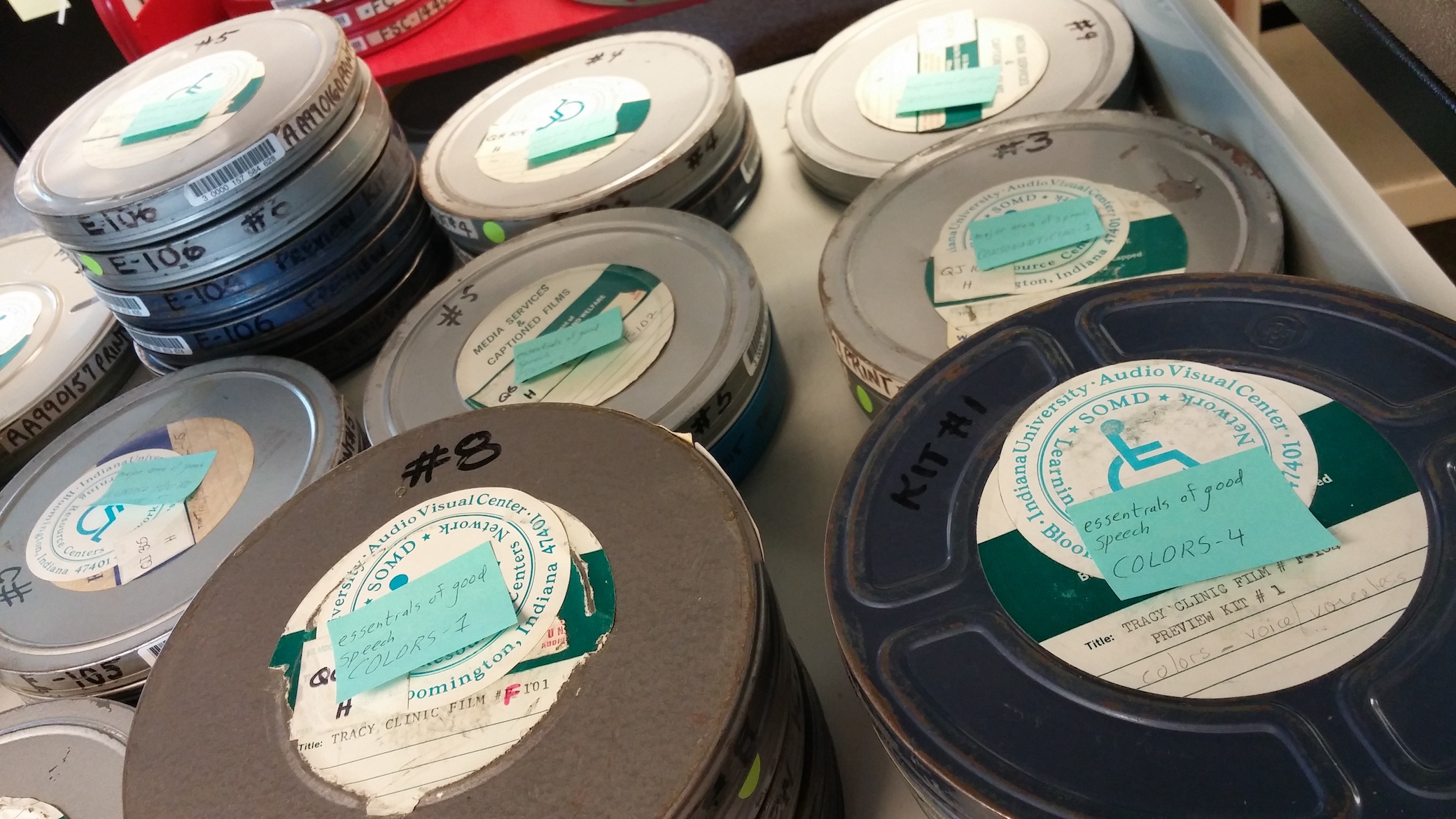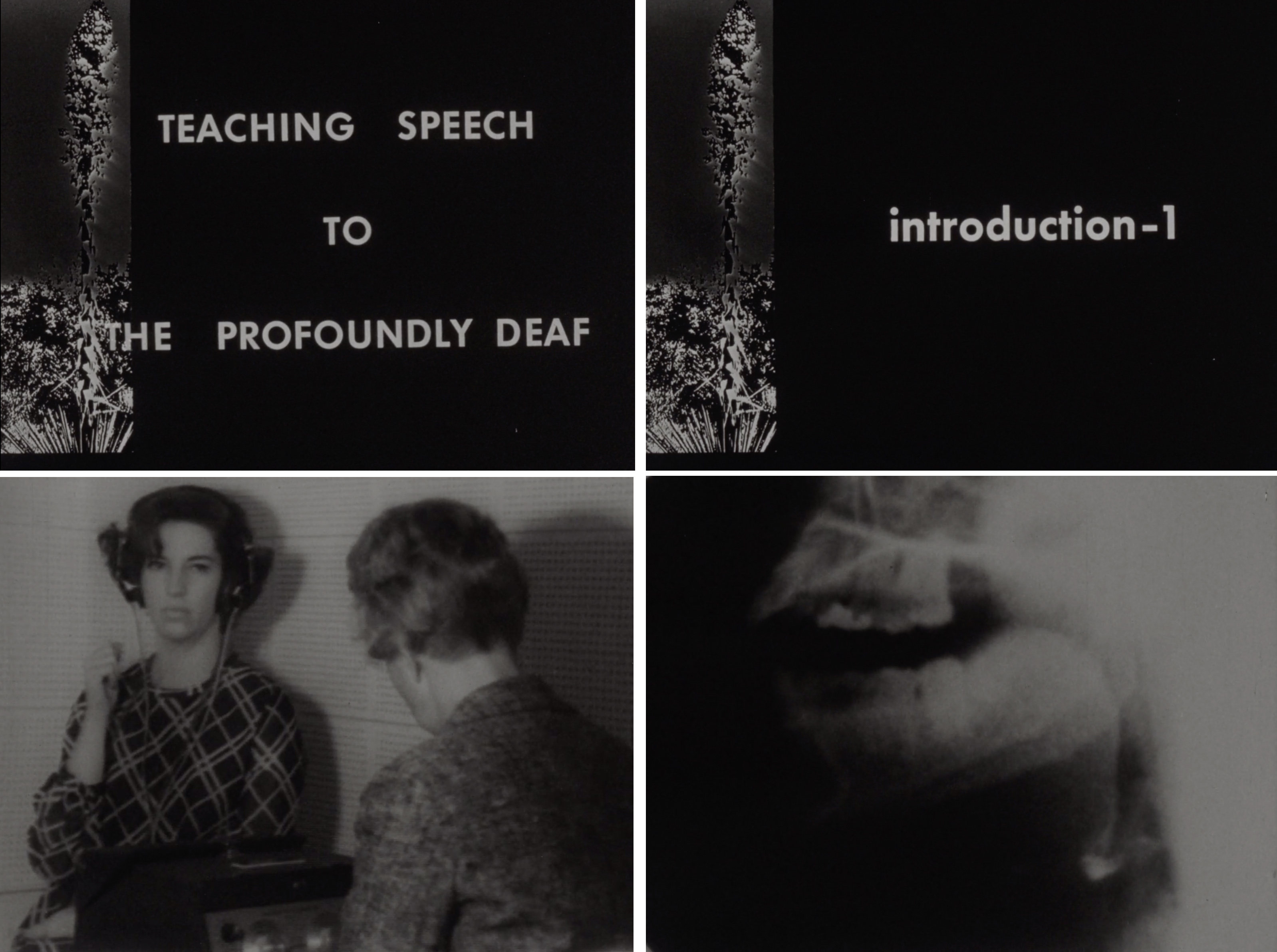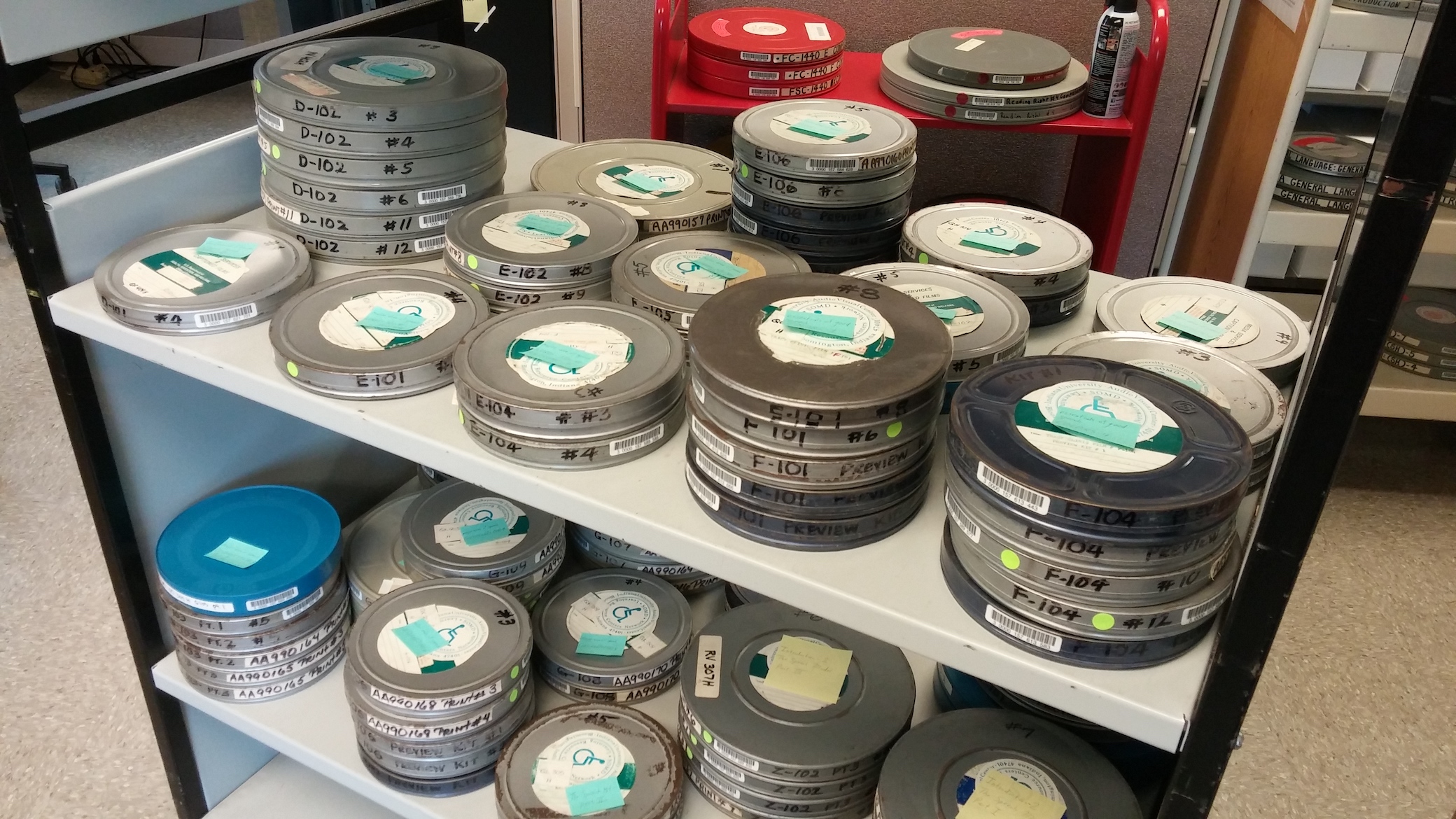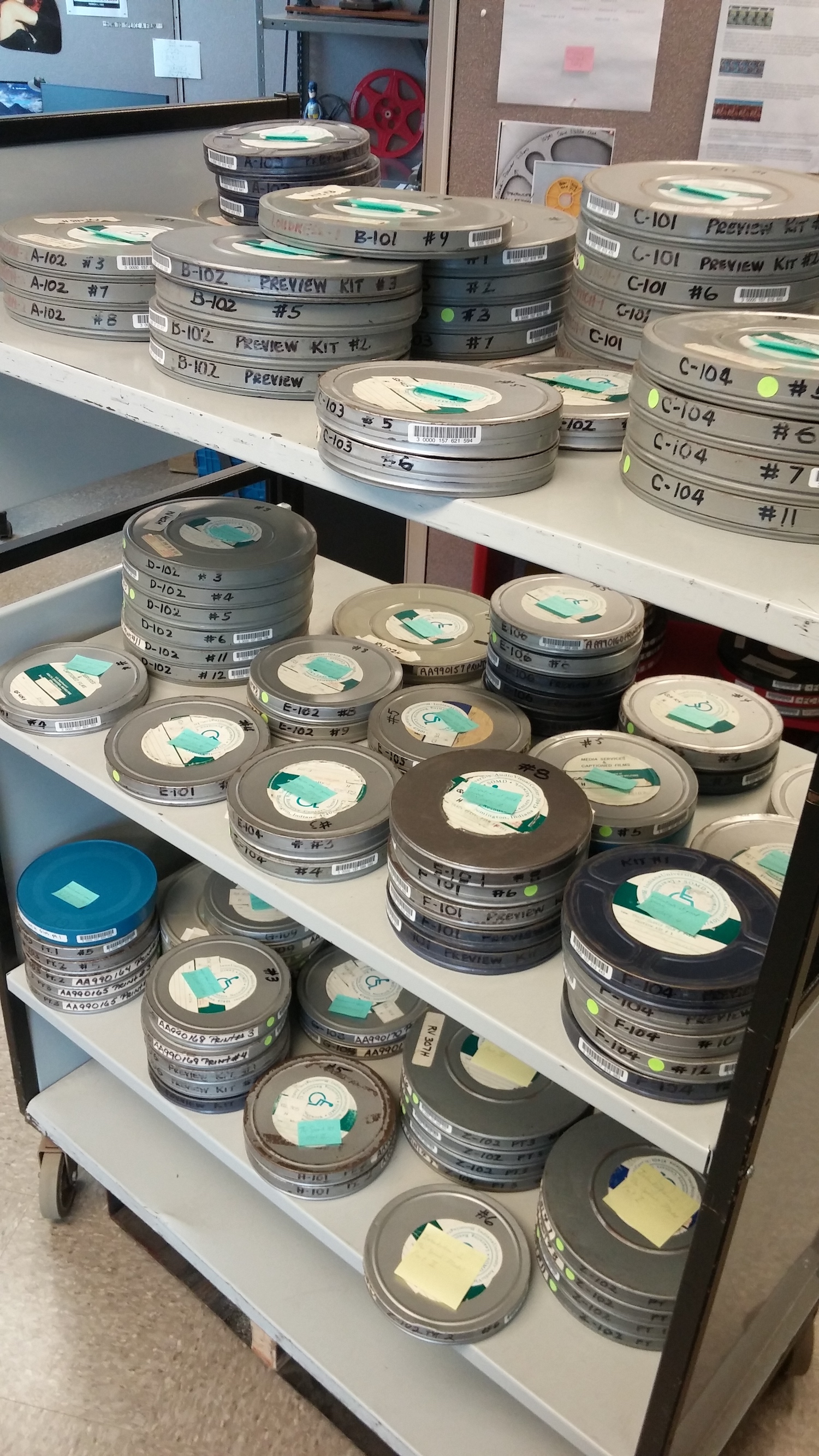By Tim Wagner
It all began so simply: two unidentified 400-foot, 16mm prints. Thus began my adventure…
For the past year-and-a-half, as part of Indiana University’s Media Digitization & Preservation Initiative (MDPI) phase 2 (film digitization), I have been performing Best Copy work on Encyclopaedia Britannica short films. This work involves comparing multiple copies of 16mm film prints, of hundreds of titles, and selecting the best copies for digitization. As an assistant film archivist at Indiana University Libraries Moving Image Archive (IULMIA), I perform this work at the Ruth Lilly Auxiliary Library Facility (ALF), where the films are stored.
Inspection of the two unidentified film prints revealed their identity: “major area of speech, CONSONANT: (SH)-4” and “major area of speech, CONSONANT: (SH)-5”. Unusual titles, I thought. Well, the head credits on these 16mm films also revealed a series title, “Teaching Speech to the Profoundly Deaf”, presented by the John Tracy Clinic. What had I discovered? Time to check our film database FilmDb.

FILMDB
Developed within the past couple years, Filmdb is a custom database for the Moving Image Archive created as part of the MDPI project. Initially populated with information imported from spreadsheet inventories, the records typically reflect basic information written on film cans, without the benefit of inspection or cataloging. Based on how films were identified, this can present some confusion. As I inspect films and gather information, I have the opportunity to properly identify them and begin populating/correcting Title Records and Physical Object Records within Filmdb.
A title search on “consonant” in our growing Filmdb database resulted in a close match to one of these prints, “CONSONANT: (SH)-4”, along with a Series Title, “Teaching Speech to the Profoundly Deaf”. Interesting. Casting a wider net, I performed a title search on the word “deaf”, revealing a mother lode of results: 41 related Title Records, along with several unrelated titles. Yikes! Among the 41 related records, I discovered two additional prints of this episode, “Teaching Speech to the Profoundly Deaf—Major Area of Speech: (Sh)-4” (missing the word “CONSONANT”, and with some different capitalization in the title). These database searches had just revealed four prints of the same episode, listed under three different Title Records, with three different variations on the same title. The shape of things to come!
Within the 41 related Title Records, the database revealed a total of 55 film prints for this series. So, I submitted a vault request for these prints and began their inspection. Little did I know that I had only scratched the surface.

TEACHING SPEECH TO THE PROFOUNDLY DEAF
Produced by the John Tracy Clinic in 1974, “Teaching Speech to the Profoundly Deaf” is a series of 42 films designed to train teachers of the deaf in the difficult art of speech instruction for those who cannot hear. Located in Los Angeles, the John Tracy Clinic was established in 1943 by Louise Treadwell Tracy, wife of actor Spencer Tracy. After Spencer and Louise Tracy’s infant son was diagnosed with a profound hearing loss in 1925, Louise Tracy devoted her time and energy to studying how deaf children could be taught to communicate with the hearing and speaking world. She patiently guided her son, John, into an understanding of language and lip-reading. With her encouragement, he learned to speak.
In 1942, Mrs. Tracy responded to a call for help from other mothers of young deaf children by founding a daycare. Louise Tracy established programs to educate and offer emotional support to parents and their preschool deaf children, free of charge. The program incorporated into the John Tracy Clinic the following year with Walt Disney as one of the first board members alongside Spencer Tracy. Known today as the John Tracy Center and serving over 25,000 families a year, the Center provides parent-centered services locally and globally to young children with hearing loss, offering families hope, guidance, and encouragement. https://www.jtc.org/
Directed by Jan Haag, Film and Television Director for the John Tracy Clinic, the 42-film series was captured via kinescope and produced for the U.S. Department of Health, Education and Welfare, Office of Education. A kinescope is a motion picture film recording of a program from a video monitor (pioneered in the 1940’s as a means to preserve and re-broadcast television programs in an era before videotape). It’s interesting to note that Ms. Haag was also on staff at the American Film Institute, where she served as Director of National Production Programs, Director of the Academy Internship Program, and founder of the AFI’s Directing Workshop for Women, a program in which women, including Joanne Woodward, Margot Kidder, Ellen Burstyn, Maya Angelou, Dyan Cannon, and Cecily Tyson, already accomplished in other aspects of filmmaking, could develop their directing skills.
You can watch the introductory episode to the series here: https://media.dlib.indiana.edu/media_objects/kw52jg21k

And here’s a link to other films in the series which have been digitized through the Media Digitization and Preservation Initiative:
http://go.iu.edu/2bG2
While inspecting the film prints a month after my initial encounter with this series, I performed a title search in the Filmdb database on “teaching speech”, revealing five additional prints in the series. A week later, based on my inspection of those five prints, I performed a title search on “speech kit”, revealing two more prints. Based on some common text appearing in the Title Records of these seven film prints, I performed a title search on “tracy clinic”, revealing 34 Title Records. 33 of these records encompassed a total of 59 more prints, and one record encompassed another 57 prints. Yikes! So, I submitted two vault requests for a total of 116 prints. I certainly had my work cut out for me.
The following month, a title search on “tracy” revealed two more film prints, and a Series Name search on “teaching speech” revealed twenty more prints of nine episodes of the series. The series without end!

So, where did they all come from? Good question! As a very young moving image archive within a 200-year-old university encompassing several campuses across the state, the provenance of collection material is not always clear or evident. The Educational Film Collection at IU was established before World War II as an outreach service of the Indiana University Extension Division. By 1945 it had nearly 500 films that were rented out for low fees to schools, public libraries, and organizations throughout the US. The collection grew to tens of thousands of 16mm films, and the Indiana University Audio-Visual Center became one of the largest education rental services in the country. The Audio-Visual Center was also the exclusive distributor of films produced by National Educational Television (NET), the predecessor to PBS. In 2006 Indiana University ended its rental service, and the collection of about 50,000 reels of 16mm film and 7,000 videos came under the care of the IU Library System.
IUCAT, the Indiana University Library Catalog, has 42 records for the “Teaching Speech to the Profoundly Deaf” series, one for each episode, encompassing 59 film prints. The records indicate that the films were gifted to Indiana University Bloomington Libraries from Instruction Support Services, the successor department to the Audio-Visual Center. So where did the rest come from? In 2016, four students processed multiple cartons of Tracy Clinic film prints which had previously been stored off-site. Documentation indicates that the majority of these prints, identified simply as “Tracy Clinic Film“, were part of the Handicapped Learner Materials Distribution Center collection, which was distributed by the Indiana University Audio-Visual Center.
The Handicapped Learner Materials Distribution Center was one of two federal agencies charged with dissemination and distribution of educational materials for the Captioned Films and Telecommunications Branch of the Division of Media Services, U.S. Office of Education, Bureau of Education for the Handicapped. The Division of Media Services was responsible for administering contracts and grants for the utilization of media and technology and providing technical and material assistance to handicapped children, teachers, state and local administrators, handicapped persons and organizations engaged in providing quality education and other services to the handicapped.
JOURNEY’S END?
What began so simply with two unidentified film prints blossomed into the discovery of 200+ prints of a 42-episode series, listed under 86 different Title Records.
• 5 episodes have 2 prints each
• 17 episodes have 3 prints each
• 1 episode has 4 prints
• 5 episodes have 6 prints each
• 8 episodes have 7 prints each
• 4 episodes have 9 prints each
• 2 episodes have 10 prints each

In addition to identifying Best Copy for each of the episodes, the benefits of this work include:
• Identification of 207 prints as part of this series
• Consolidation into 42 correct Title Records
• Population of the Title Records
• Providing intellectual control of this series
The phase 2 work on Indiana University’s Media Digitization & Preservation Initiative is providing, for the first time, intellectual control over all the film collections, and it’s a pleasure to be a part of this important work!
– Tim Wagner, Assistant Film Archivist at Indiana University Libraries Moving Image Archive (IULMIA)
3 Comments
While walking recently I found 3 of these film cans. I’m going to try and take them to the clinic in hopes of them maybe putting them on display, or returning them to the rightful owner. Thanks for the read, I really didn’t know much about then until now.
Wow, Tim! What a great piece of detective work in preserving an important document about the development of speech instruction. What must have felt to you as a rather routine and tedious assignment must have had your heart racing as the project came to such a successful, important, and unexpected conclusion. Bravo!
Matthew Caulfield
Incredible and invaluable work that needed to be done to preserve past educational materials. How can anyone create new techniques without the solid knowledge of what has come before. Thank you for all of your hard work